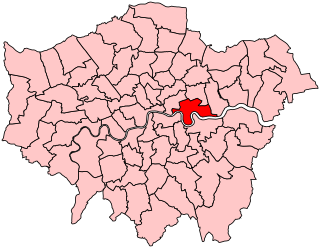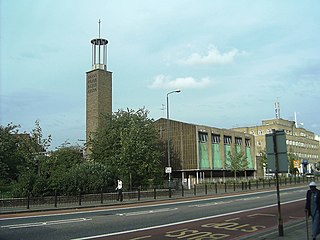
Poplar is a district in East London, England and is in the London Borough of Tower Hamlets. It is an inner-city suburb located five miles (8 km) east of Charing Cross and lays on the western bank of the River Lea and is part of the London Docklands.

The London Borough of Tower Hamlets is a borough of London, England. Situated on the north bank of the River Thames and immediately east of the City of London, the borough spans much of the traditional East End of London and includes much of the regenerated London Docklands area. The 2019 mid-year population for the borough is estimated at 324,745.

Poplar was a local government district in the metropolitan area of London, England. It was formed as a district of the Metropolis in 1855 and became a metropolitan borough in the County of London in 1900. It comprised Poplar, Millwall, Bromley-by-Bow and Bow as well as Old Ford, Fish Island and Cubitt Town.

The Lansbury Estate is a large, historic council housing estate in Poplar and Bromley-by-Bow in the London Borough of Tower Hamlets. It is named after George Lansbury, a Poplar councillor and Labour Party MP.

Balfron Tower is a 26-storey residential building in Poplar, located in the London Borough of Tower Hamlets, London. Built in a Brutalist style, it forms part of the Brownfield Estate, an area of social housing between Chrisp Street Market and the A12 northern approach to the Blackwall Tunnel. It was designed by Ernő Goldfinger in 1963 for the London County Council, built 1965–67 by the GLC, and has been a listed building since 1996. Balfron Tower is stylistically similar to Goldfinger's later Trellick Tower in North Kensington, within West London

Blackwall is an area of Poplar, in the London Borough of Tower Hamlets, East London. The neighbourhood includes Leamouth and the Coldharbour conservation area.

Cubitt Town is a district on the eastern side of the Isle of Dogs in London, England. This part of the former Metropolitan Borough of Poplar was redeveloped as part of the Port of London in the 1840s and 1850s by William Cubitt, Lord Mayor of London (1860–1862), after whom it is named. It is on the east of the Isle, facing the Royal Borough of Greenwich across the River Thames. To the west is Millwall, to the east and south is Greenwich, to the northwest Canary Wharf, and to the north — across the Blue Bridge — is Blackwall. The district is situated within the Blackwall & Cubitt Town Ward of Tower Hamlets London Borough Council.

Bow is a district in East London, England and is in the London Borough of Tower Hamlets. It is an inner-city suburb located 4.6 miles (7.4 km) east of Charing Cross.

Leamouth is a locality in the Blackwall area of Poplar, in the London Borough of Tower Hamlets. The area takes its name from the former Leamouth Wharf and lies on the west side of the confluence of the Bow Creek stretch of the Lea, at its confluence with the River Thames.

Poplar and Canning Town was a borough constituency represented in the House of Commons of the Parliament of the United Kingdom. It elected one Member of Parliament (MP) by the first past the post system of election.

Poplar and Limehouse is a constituency created in 2010 and represented in the House of Commons of the UK Parliament since 2019 by Apsana Begum of the Labour Party until her suspension and whip withdrawn on 23 July 2024, as a result of voting to scrap the two child benefit cap. She now sits as an Independent MP until the whip is re-established.

The Survey of London is a research project to produce a comprehensive architectural survey of central London and its suburbs, or the area formerly administered by the London County Council. It was founded in 1894 by Charles Robert Ashbee, an Arts-and-Crafts designer, architect and social reformer and was motivated by a desire to record and preserve London's ancient monuments. The first volume was published in 1900, but the completion of the series remains far in the future.

The East India Docks were a group of docks in Blackwall, east London, north-east of the Isle of Dogs. Today only the entrance basin and listed perimeter wall remain visible.

The Trinity Independent Chapel was an early Victorian church in Poplar. It was destroyed by a V-2 rocket hit during the Second World War, and later re-built in Modernist style. In the late 1990s the building was sold to the Calvary Charismatic Baptist Church, and since then has served as their Prayer Temple and international headquarters.

Tower Hamlets London Borough Council, also known as Tower Hamlets Council, is the local authority for the London Borough of Tower Hamlets in Greater London, England. It is a London borough council, one of 32 in London. The council has been under the majority control of local party Aspire since 2022. It has been led by a directly elected mayor since 2010. The council is based at Tower Hamlets Town Hall on Whitechapel Road.

East India Dock Road is a major arterial route from Limehouse to Canning Town in London. The road takes its name from the former East India Docks in the Port of London. To the west it becomes Commercial Road and to the east Newham Way. It forms part of the A13, a major road connecting the historic City of London to Tilbury and Southend.

Mulberry Place, formerly Tower Hamlets Town Hall, is a building in Nutmeg Lane, Blackwall, London. It was the headquarters of Tower Hamlets London Borough Council from 1992 to 2023, before their relocation to the new Tower Hamlets Town Hall in Whitechapel Road.

Poplar Town Hall is a municipal building at the corner of Bow Road and Fairfield Road in Poplar, London. It is a Grade II listed building.

Mayflower Primary School is a primary school in the Poplar area of East London in the London Borough of Tower Hamlets. Originating in 1843 and formerly called Upper North Street School, it was badly damaged in an air raid in 1917 during the First World War, resulting in the deaths of eighteen children. The school was rebuilt in 1928 and adopted its present name in 1952. The school was judged to be "outstanding" at an Ofsted inspection in 2017, and was awarded the title "Primary School of the Year" in 2020 by a national newspaper.



















